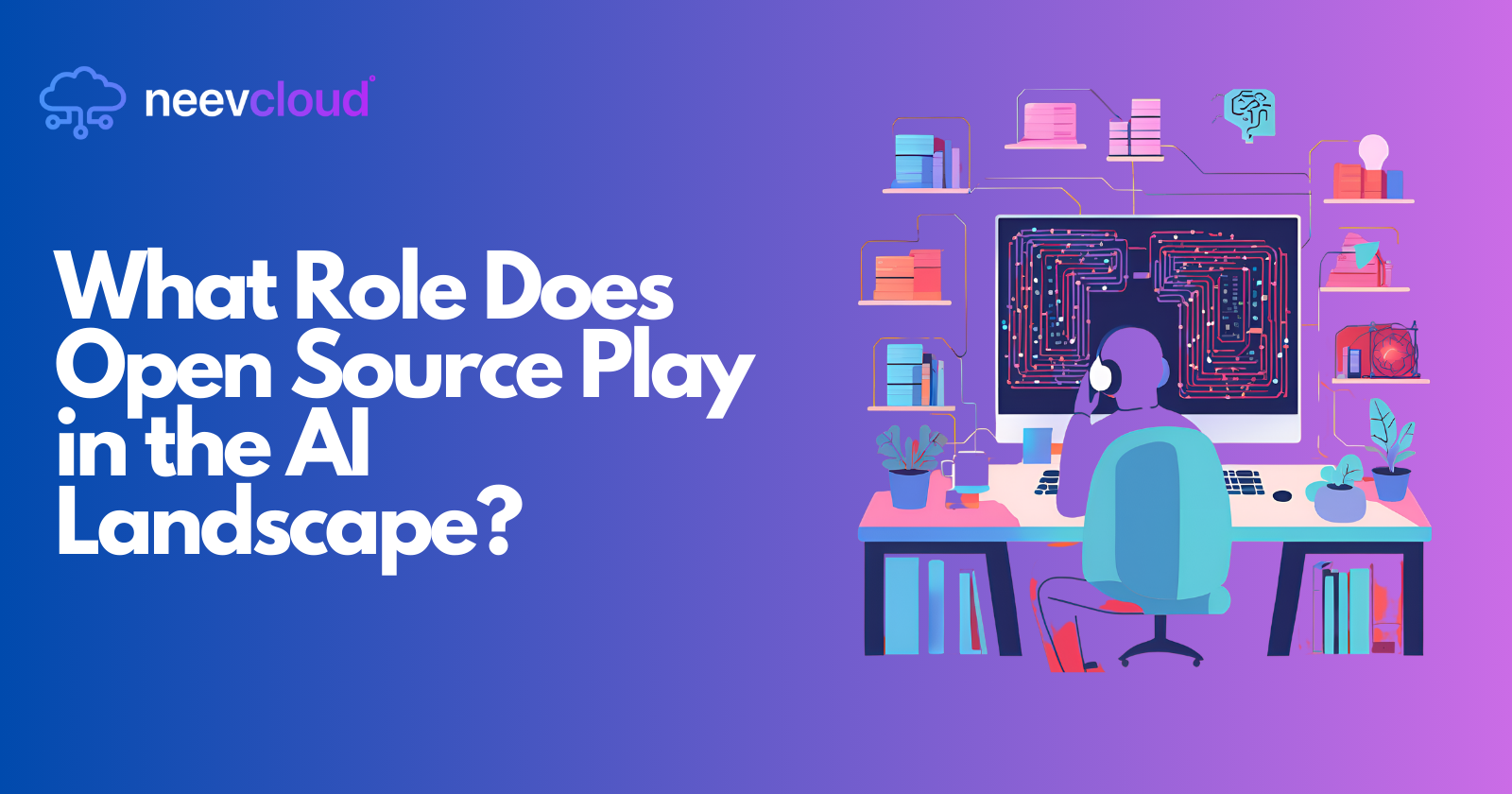What Role Does Open Source Play in the AI Landscape?
 Tanvi Ausare
Tanvi Ausare
Artificial Intelligence (AI) is transforming the world, and open-source software is playing a pivotal role in this transformation. By democratizing access to advanced tools and algorithms, open-source has become foundational in accelerating AI development, enabling collaboration, and reducing the barriers to innovation. But what exactly makes open-source so significant in the AI landscape? In this article, we’ll dive into how open-source software influences various aspects of AI—from AI Cloud to AI Datacenter and everything in between.
Table of Contents
Introduction to Open Source in AI
Benefits of Open Source for AI Development
Open Source in AI Cloud and AI Cloud Infrastructure
Key Open Source Projects Shaping the AI Cloud
Role of Open Source in AI Datacenters
Open Source and Cost Reduction for AI Cloud Servers
Challenges and Considerations
The Future of Open Source in AI
Introduction to Open Source in AI
The open-source movement has redefined how we approach software development. With AI’s rapid evolution, open-source frameworks and platforms have become indispensable in:
Creating accessibility for AI tools that were once available only to large enterprises.
Encouraging innovation by allowing developers to build upon each other’s work.
Reducing costs associated with developing and maintaining proprietary software.
As AI scales across industries, open-source software is foundational for building scalable, flexible, and cost-effective solutions in the AI Cloud and AI Datacenter environments.
Benefits of Open Source for AI Development
Open source brings several critical benefits that are instrumental to the AI landscape:
Transparency and Accountability: Open-source codebases allow anyone to inspect, audit, and verify the inner workings of an algorithm or tool, increasing trust.
Collaborative Innovation: Open-source communities enable developers across the world to work together, share ideas, and solve complex problems collectively.
Accelerated Development: Contributions from a diverse group of developers ensure rapid improvements, bug fixes, and updates to the codebase.
Cost Efficiency: Open-source tools eliminate licensing fees and enable enterprises to save on infrastructure, especially for resource-intensive tasks in AI Cloud Servers.
These benefits create an environment where cutting-edge AI development can occur quickly and more affordably than ever before.
Open Source in AI Cloud and AI Cloud Infrastructure
As AI increasingly relies on cloud infrastructure, open-source projects play a crucial role in making AI Cloud accessible and manageable.
Flexible Deployments: Open-source cloud platforms like Kubernetes allow organizations to deploy AI models in highly scalable, containerized environments, ensuring seamless integration into existing AI Cloud Infrastructure.
Hybrid and Multi-Cloud Flexibility: Open-source tools provide the flexibility to deploy and manage AI workloads across public and private clouds, enhancing operational flexibility in AI Cloud Servers.
Platform Independence: Open-source platforms and libraries provide a vendor-neutral option, allowing enterprises to avoid vendor lock-in and adopt tools that best fit their unique AI requirements.
Reduced Cost Barriers: By eliminating licensing fees and offering flexibility, open-source software enables companies to leverage high-performance AI Cloud Servers without exorbitant costs.
As AI continues to scale, the synergy between open-source solutions and AI Cloud will become more pronounced, helping organizations innovate without compromising cost-efficiency.
Key Open Source Projects Shaping the AI Cloud
Several prominent open-source projects are leading the way in defining the AI Cloud and AI Datacenter environments:
TensorFlow:
Developed by Google, TensorFlow is one of the most popular open-source AI libraries for deep learning.
It supports distributed computing, making it ideal for cloud-based AI workloads.
PyTorch:
Known for its ease of use and flexibility, PyTorch is widely adopted in research and production.
Its integration with platforms like AI Cloud Infrastructure makes it a preferred choice for many businesses.
Kubernetes:
This open-source platform for managing containerized applications has become crucial for AI.
Kubernetes supports scalable AI workloads across AI Datacenters and cloud environments, providing deployment flexibility and resilience.
ONNX (Open Neural Network Exchange):
ONNX is an open-source format for AI models that allows interoperability between different AI frameworks.
It is ideal for deploying models on different AI Cloud Servers and AI Cloud Infrastructure, enhancing compatibility and performance.
Apache Kafka:
Kafka is used for real-time data streaming and is widely adopted in data-driven AI applications.
It supports AI Datacenters with the real-time data handling capability needed for dynamic and responsive AI applications.
These tools are integral to making AI on the cloud a reality, empowering developers and enterprises alike to create, deploy, and scale AI applications efficiently.
Role of Open Source in AI Datacenters
AI Datacenters are high-performance computing environments specifically designed for training and deploying AI models. Open-source plays a critical role in AI Datacenters in several ways:
High Performance: Open-source frameworks optimized for hardware acceleration, like TensorFlow and PyTorch, leverage GPUs and TPUs for high-speed computations.
Modular Architecture: Open-source solutions enable custom configurations that suit unique AI requirements, making them ideal for specialized AI Datacenters.
Management and Monitoring: Open-source tools like Prometheus and Grafana allow real-time monitoring of AI workloads and system performance, essential for efficient AI Datacenter operations.
Energy Efficiency: As sustainability becomes a priority, open-source software helps manage power usage in AI Datacenters through optimized code and lightweight frameworks that reduce computational load.
By providing robust tools tailored to manage data-intensive workloads, open-source software is a cornerstone in making AI Datacenters powerful, cost-effective, and energy-efficient.
Open Source and Cost Reduction for AI Cloud Servers
With AI adoption accelerating, cost reduction has become a priority for enterprises. Open-source technologies help organizations lower their total cost of ownership (TCO) in the following ways:
Avoiding Proprietary Licensing Costs: Open-source eliminates costly licensing, making it possible to allocate resources more efficiently across AI Cloud Servers.
Scalability Without Extra Costs: As AI workloads increase, open-source software scales efficiently across multiple servers, maintaining cost efficiency.
Reuse and Modular Architecture: Open-source frameworks are modular and customizable, allowing enterprises to tailor solutions for AI Cloud Infrastructure without costly vendor dependencies.
Operational Efficiency: Open-source AI frameworks offer built-in optimization and support for high-performance computing (HPC), helping organizations get the most from their AI Cloud Servers.
For companies deploying large-scale AI, open-source is an attractive option, providing robust functionality without the high costs associated with proprietary software.
Challenges and Considerations
While open-source offers tremendous benefits, it’s not without its challenges. Some considerations include:
Security and Compliance: With open-source software, ensuring compliance and security can be complex, as the code is publicly accessible.
Maintenance and Support: Open-source tools often require internal maintenance and support, which may necessitate specialized skills or dedicated teams.
Performance Optimization: Open-source AI frameworks may need significant tuning for optimal performance on specific AI Cloud Infrastructure, which can be time-consuming.
Despite these challenges, open-source continues to thrive in the AI landscape due to its adaptability, community-driven innovation, and reduced costs.
The Future of Open Source in AI
As AI technology evolves, so too will the role of open-source in shaping the future of AI Cloud and Datacenter solutions. Emerging trends that may influence the future include:
Increased Emphasis on Ethical AI: Open-source tools foster transparency and allow for community-driven ethical standards, ensuring AI applications are fair, transparent, and unbiased.
Integration with Quantum Computing: As quantum computing matures, open-source software may offer the first frameworks for developing quantum AI applications.
Enhanced Interoperability: Projects like ONNX may grow to allow even greater interoperability across diverse AI Cloud Infrastructure and hardware.
Greater Focus on Sustainability: Open-source projects can drive energy-efficient AI solutions that help meet global sustainability goals, critical for both AI Cloud Servers and Datacenters.
Open-source will undoubtedly continue to drive the AI landscape forward, providing a foundation for accessible, innovative, and ethical AI development.
Conclusion
The open-source movement has provided a critical boost to the AI landscape, shaping how enterprises approach AI Cloud, AI Datacenter, and AI Infrastructure development. From cost savings to innovation, open-source offers benefits that are transforming the way AI is built, deployed, and scaled. For enterprises looking to leverage AI Cloud and Datacenter solutions, open-source software remains an indispensable asset, empowering them to innovate rapidly while keeping costs manageable.
Whether you’re an AI researcher, data scientist, or enterprise looking to integrate AI, open-source offers the resources and community support needed to transform ideas into impactful solutions.
Subscribe to my newsletter
Read articles from Tanvi Ausare directly inside your inbox. Subscribe to the newsletter, and don't miss out.
Written by
